Project Tag: Visual Design
Seattle in Progress: Web App
Seattle in Progress: Web App

Role
Lead Product Designer
Scope of Work
Mini Design System, Prototyping, UX Design, UI Design, Visual Design
Seattle in Progress set out to give residents greater visibility into the development of their city by providing easy access to upcoming construction and land development plans.
Duration. 3 months, Completed in 2015
Opportunity. Seattle in Progress tracks construction projects throughout Seattle from application to completion, giving local residents and businesses a way to stay informed at each step of the process, right from their phones. The founder approached me to improve the UX and UI in preparation for creating a white label offering as well as a paid subscription.
Approach. I worked with the founder/developer directly to refine their style guide and make simple design updates that could be executed with little effort in CSS and HTML. The need to differentiate this product was unusually high since a look-alike app had recently launched. With this in mind, I looked for ways to solidify the Seattle in Progress identity and position the product as a more enjoyable, robust interface. As companies showed interest in the white label option, I provided branded mockups and collateral to pitch the idea.
Outcome. The founder ultimately decided not to implement the new app design, as he transitioned his focus to other projects. The free app continues to provide value to users many years later.


The need to differentiate this product was unusually high due to the fact that another organization had copied it almost down to the pixel. Rather than seeking legal retribution, the founder took the opportunity to level up his app and amplify its value with a superior UX and UI. With this in mind, I emphasized the Seattle in Progress brand throughout the UI, and used minimalist UI elements and bold color blocking to polish the look.
Before. Primary Navigation Bar

After. Primary Navigation Bar

The scope of the project was limited to improving how existing elements displayed on screen. Redefining the page hierarchy, element positioning, typography, colors and spacing modernized the look and feel instantly, and made it easier to find tools throughout the interface.
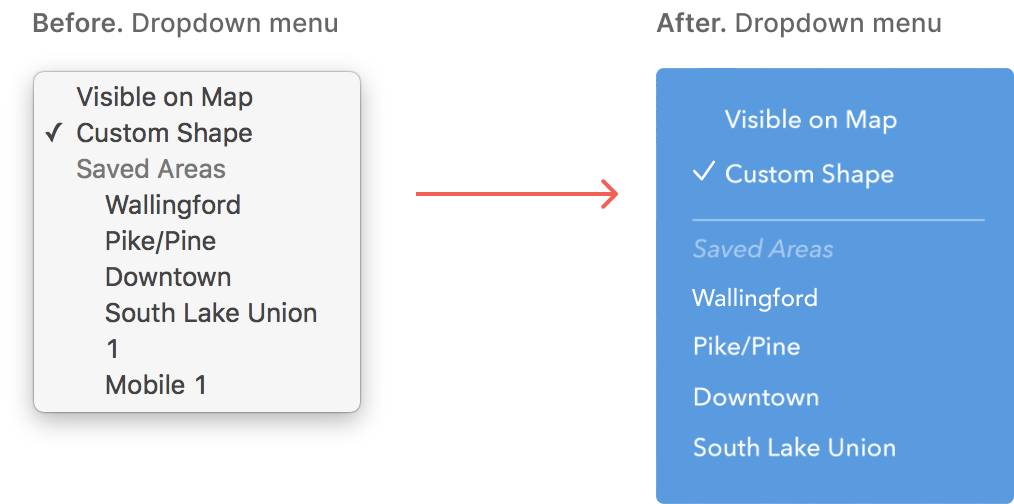
As the map and listings were the primary focus of the app, I paid close attention to reducing visual clutter and removing unnecessary elements to create a clean working space for users. This involved swapping default map location beacons for smaller jewel-like nodes, simplifying the map colors to a monochromatic palette, and repositioning tools.
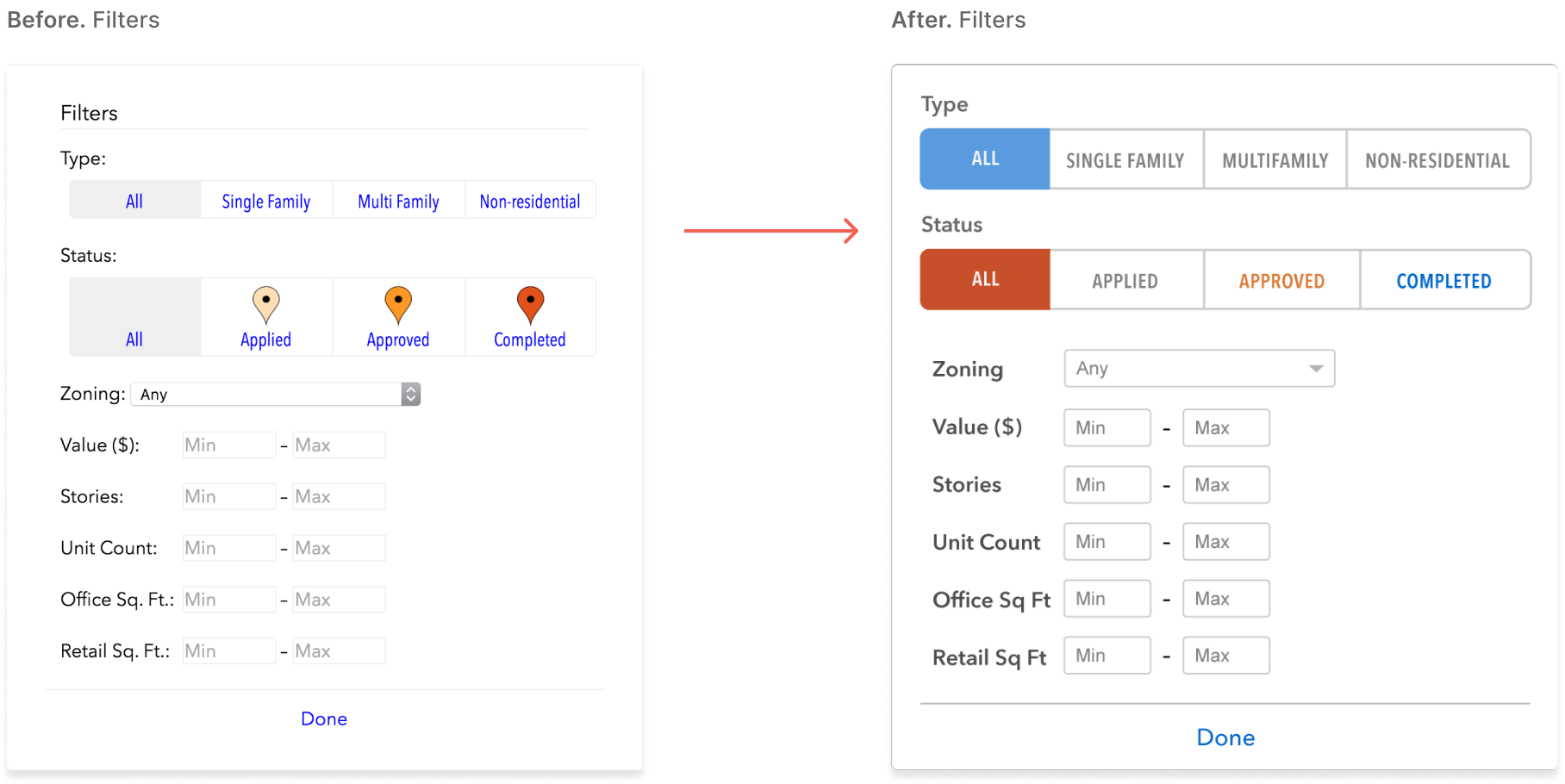
The responsive web app was ideal for users looking to explore details about construction projects as they encountered them throughout Seattle. The modular design and bold colors translated well across both desktops and mobile devices.
Before. Mobile view

After. Mobile view

After. Mobile experience

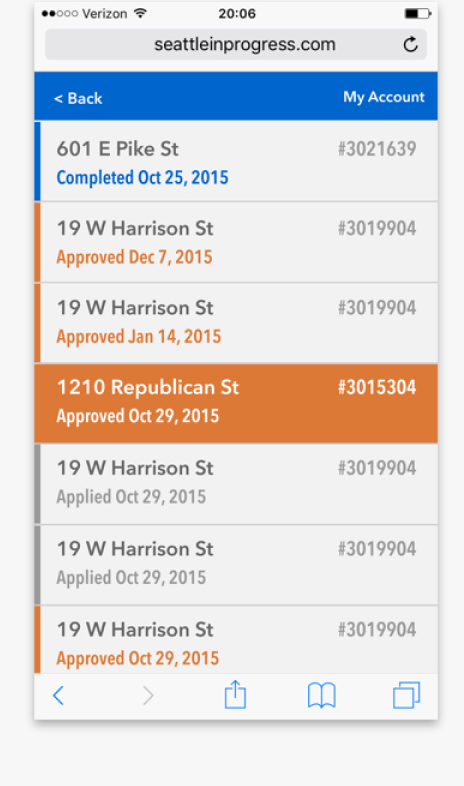

In parallel with updating their new app, I helped Seattle in Progress develop a white-label version of the app to generate a new revenue stream.

Digital Alchemy: iOS App
Digital Alchemy: Bank Loan iOS App
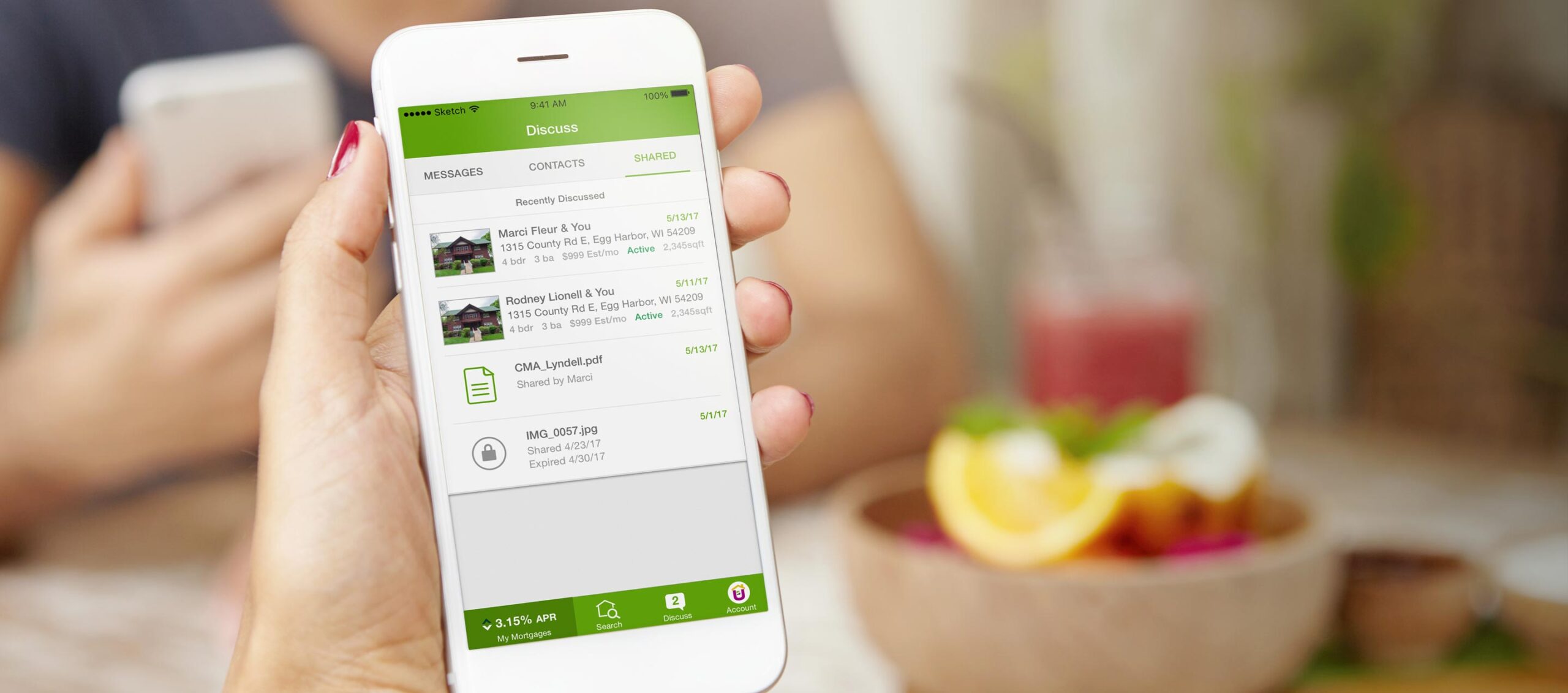
Role
Lead Product Designer
Scope of Work
User Research, iOS App Design, Prototyping, UX Design, UI Design, Visual Design, Interaction Design
Digital Alchemy uses the power of mobile technology to connect house hunters and homeowners with trusted financial professionals. This white label bank iOS app allows users to discover new real estate opportunities, then guides them through comparison shopping for mortgage rates and applying for a loan.
Duration. 9 months, completed in 2017
Opportunity. Digital Alchemy is a white label financial product for real estate brokers and agents. It non-intrusively guides home owners and house hunters through each stage of the home financing process with in-depth information uncommonly found in tools for mass markets. For house hunters, this means less time spent hunting down agents' and loan officers' contact information or sifting through emails. For agents and loan officers, the app provides a direct connection to clients, while guiding them through a simplified experience, reducing repeated questions and back-and-forth communication.
Approach. I worked directly with the executive team. They requested targeted support to validate their product offering for three audience segments, explore UX and UI design enhancements to their existing app, and create a system of matching collateral and branded app themes customized for each financial institution. In addition to conducting user research, I proposed a plan to improve the app's readability and establish the interactive experience of launching the white label app for different brands. I also provided prototypes to present to prospects to help close deals.
Outcome. Digital Alchemy was able to launch their app with multiple financial institutions. They sold their company and suite of products three years later.
User Research

Surveys
I emailed a 9-question survey to a group of pre-screened participants, all of whom owned an iPhone and had experience with real estate apps. This included current renters, current and former home owners, and those who had invested in multiple properties. The surveys revealed differences in how they approached the home-buying process, and their comfort level for using an app to communicate with agents and loan officers.
User Interviews & Usability Testing
To learn whether the existing screens and flows were providing adequate information, I conducted in-person and virtual usability tests using a prototype of the current app design. The feedback drew attention to readability issues, and highlighted the information different personas tended to prioritize first when searching for properties.
As always, speaking with participants directly provided a wealth of information about how they preferred to use technology in their property search and engagement with real estate and financial professionals. For example, investors who were more familiar with the real estate process strongly preferred viewing additional fine-grained financial details, and therefore preferred accessing this app from a larger screen.

Before. Landing page and property details page
Customer Journey: Finding a Desirable Property
A house hunter's journey to find a property is long and meandering. This meant that the app needed to be flexible enough to account for the number of times a user may need to research properties before they were ready to put in an offer, or, in many cases, another offer.
Assessing Property Financials
Keeping an eye on interest rates is top-of-mind for house-hunters. I explored a few design concepts that would allow users to cycle through saved mortgage rates without having to navigate through the app to get to them.

Dynamic sliders. Users could explore financing options based on their desired downpayment.

Cash-to-close. Cash to close is a complex set of calculations, so scrolling is required to see it all (hover to scroll).

Saved for comparison. Weighing the pros and cons of each loan was made easier by consolidating saved estimates in one place.
Discovering Mortgage Options
Keeping an eye on interest rates is top-of-mind for house-hunters. I explored a few design concepts that would allow users to cycle through saved mortgage rates without having to navigate through the app to get to them.

Saved mortgages. The ability to save mortgage rates made it easier to shop, compare and revisit options.

Expanding tab bar. A long-press would animate to display mortgage details, and allow the user to cycle through a few saved mortgages.

Stock-ticker style mortgages. This treatment allowed users to glance at interest rates as they scrolled across the screen. They could drag to view previous and next rates.
Messaging
Discussion threads support conversations with verified loan officers assigned via the app, as well as personal contacts, such as a spouse who may need to co-sign documents. Images, property links and documents are consolidated from messages in a separate area for easy reference.

New Message. Contact names would populate as users typed.

Message inbox. Arranged with most recent messages on top.

Contacts. Loan officers' images were automatically imported, and were used to help build trust.

Contact search. Dynamic search made it faster to find contacts by typing the first letter or two.

Shared—Empty State. Until property links or documents are shared, this is displayed.

Shared Content. Both property links and documents could be communicated in-app, cutting down on cluttered email inboxes.

Message archives. Discussions can get long, so the app archives them by month. Tapping on the count unfurls them for viewing.

Unarchived messages. After a session, the messages archive again to keep threads tidy. (hover to scroll)
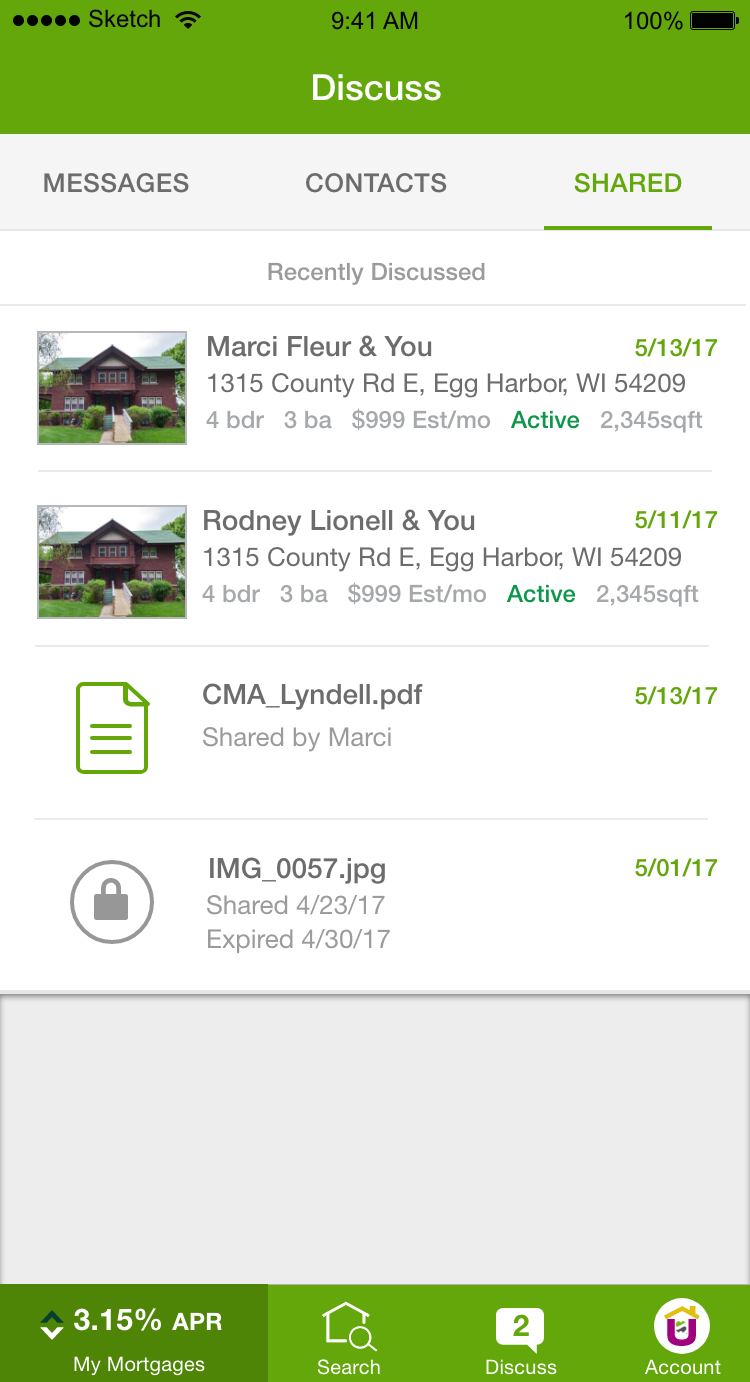
Built-in organization. Important content is consolidated in one place keeps all parties organized throughout the process.

Save time uploading. Rather than using a scanner, users could take pictures from their phone and upload important documents to keep things moving.

Automatically locked content. As an extra security precaution, sensitive documents could be set to expire after a number of days.
Mortgage Application
The app drastically reduced the burden of finding properties, gathering and comparing mortgage estimates, and hunting down loan officers' contact information. Once a house-hunter found their ideal property, the app made it convenient to connect them with a loan officer directly to begin their mortgage application.
Convenient in-app messaging. Rather than having to hunt for a loan officer, users could simply click a button to be connected with one in-app.


Recent Threads. If a discussion had previously been initiated, the thread would conveniently appear above the message box so users didn't accidentally contact multiple loan officers.
Loan Application Status. Once an application is submitted, house-hunters can see the status as it moves throughout the lengthy approval process.


A face to go with a name. The loan officer's portrait appears next to the status bar to reassure the user they're in good hands.
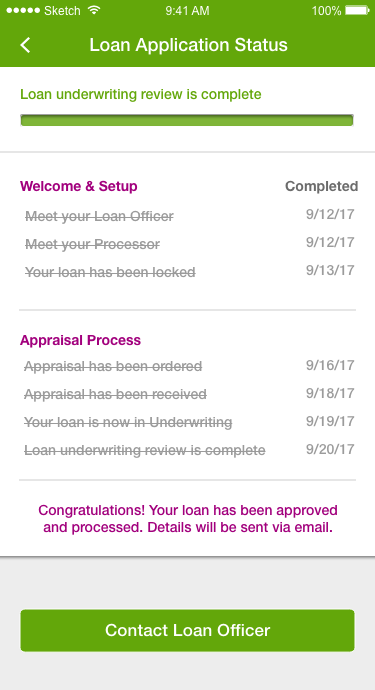
Confirmation. Once the loan is approved, a confirmation message is displayed, and the loan application process is marked complete.
Backup of Redox Podcast
The Redox Podcast
When Redox took to the airwaves to tackle the toughest questions in healthcare, we worked with them to expand their brand into audio experiences.

SERVICES
Design, Development, Music Selection
PROJECT TYPE
Logo Design, Website Design & Development, Web App Integration, Marketing Templates
Collaborating with Redox and their PR team, we coordinated the creation and launch of Redox's new podcast series about the challenges of modern healthcare. We crafted the podcast cover image, selected the intro music to use as sonic branding for each episode, created the graphics to promote the episodes on various platforms, designed the episode content structure for landing pages, designed and developed a new section of their marketing website for the podcast episodes and integrated it with the necessary third party tools to deliver the podcast across platforms and capture leads.
To support their in-house marketing team beyond the launch of the podcast, we built a system of templates for them to quickly and easily generate the graphics, landing pages and descriptions to promote each subsequent episode. Featuring high-profile guests like Jonathan Bush and Mint.com founder, Aaron Patzer, the newly branded podcast was an immediate success, attracting an initial audience of over 1,000 listeners and further establishing Redox as a thought leader in healthcare technology.




Redox Podcast
The Redox Podcast

Role
Creative Director, Visual Designer, Interaction Designer
Scope of Work
Logo Design, Website Design & Development, Web App Integration, Marketing Website Custom Post, Branded Asset Templates, Music Curation, Mini Design System
When Redox took to the airwaves to tackle tough questions in healthcare, I expanded their brand into audio experiences, with templates and integrations to streamline the broadcast.
Approach. In collaboration with Redox executives and their PR team, I oversaw the creation and launch of Redox's new podcast series about the challenges of modern healthcare, and technology's role in improving patient experiences.
Opportunity. Serving multiple roles, my work ranged from project management and creative direction, to creating both the workflow and assets needed to launch each new podcast episode. I brought in a full-stack engineer to integrate the podcast with various third party tools so it could be simultaneously broadcast across multiple platforms, and promoted easily from their marketing website.
Outcome. I built a mini Design System, including page templates, website components, and visual assets to allow their marketing team to generate the graphics, transcription highlights, landing pages and descriptions for each episode in minutes. Featuring high-profile guests like Jonathan Bush, and Mint.com founder, Aaron Patzer, the newly branded podcast was an immediate success, attracting an initial audience of over 1,000 listeners and further establishing Redox as a thought leader in healthcare technology.
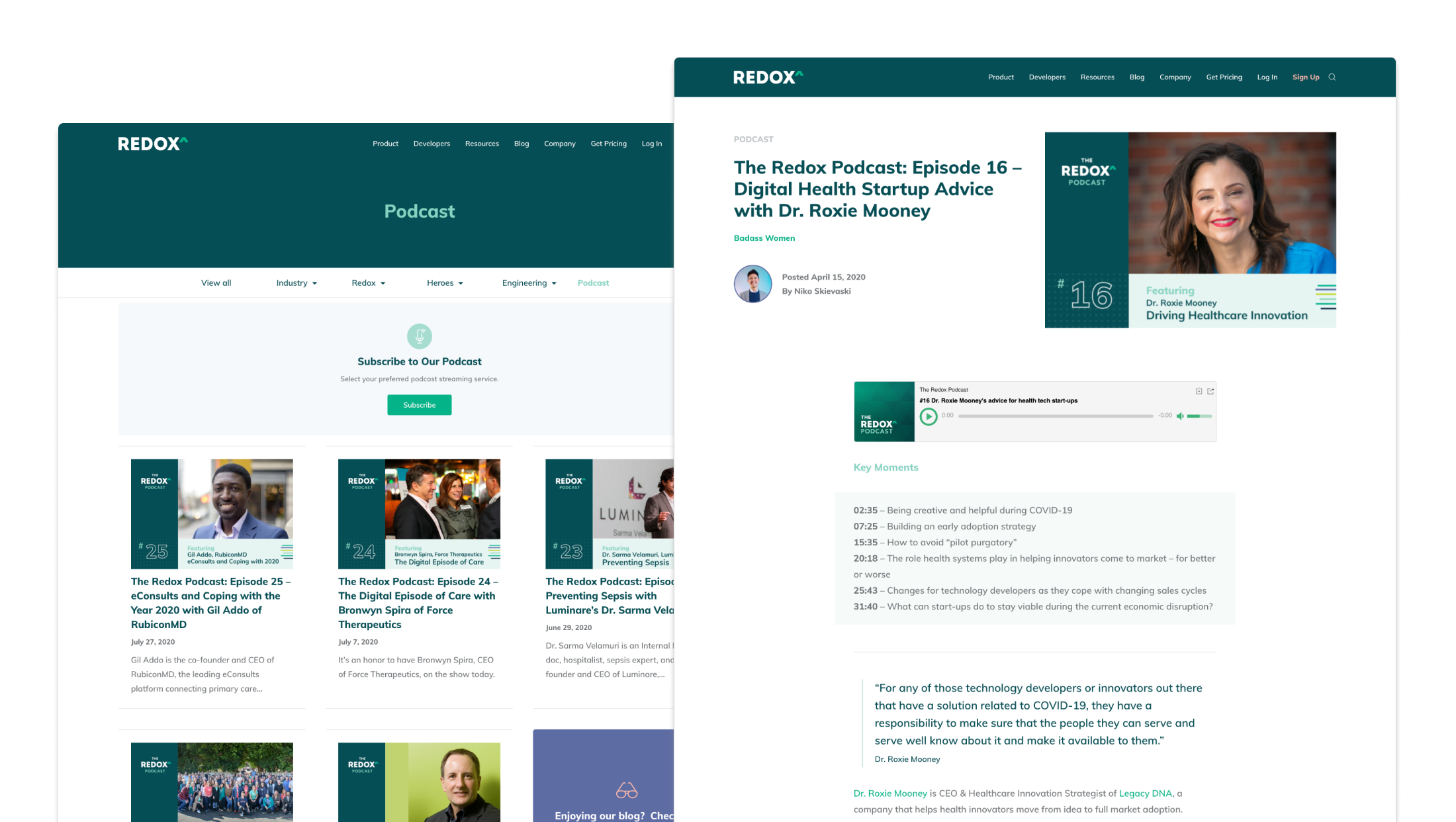

To reduce the workload and number of assets needed to publish each podcast episode, I created a series of assets and templates. This made it a light lift to both create and promote the podcast.


I selected music to use as a branded intro for the podcast. The track needed to strike the right tone to match the seriousness of the subject matter with their optimistic outlook.


User flow:
Subscribe via Redox Blog
User flow:
Discover and subscribe to podcast via LinkedIn









You must be logged in to post a comment.